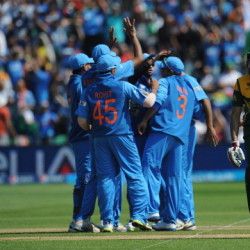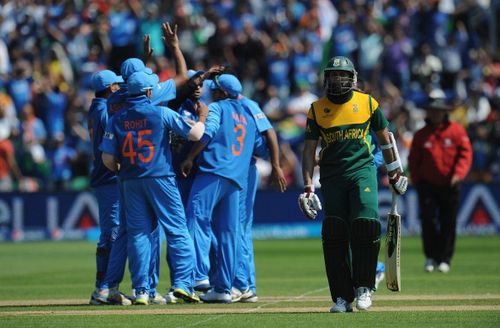
Decoding India's achilles heel

Hashim Amla departs as Indian cricket players celebrate
India chase down 359 with 6 overs to spare against a formidable Australian bowling attack. Rohit Sharma immortalizes himself as the third ever batsman to score a double hundred in One Day Internationals. Virat Kohli scorches his way to the fastest ever hundred by an Indian. Mohammed Shami dazzles with a prodigious show of swing bowling. Rohit Sharma is a world beater. Virat Kohli – The best batsman in the world. Shami – The man to save the face of Indian fast bowling. The Indian cricket team – the greatest to have played the game.
Come South Africa –Two ODIs played – 638 runs conceded – 10 wickets picked up -363 runs scored – Losses in both ODIs with mammoth margins.
We all knew the series away to South Africa was going to be the litmus test which would prove how far the Indian cricket team has actually come. The statistics are damning. The answer is there for all to see.
If you are an Indian cricket fan, look away.
India has won a meager 27 ODI matches off the 92 they have played, away from home in the last two decades, at venues, renowned to assist pace bowling – Australia, New Zealand, South Africa and England. Yes, that is a 29% win record, for a country, which has had a plethora of talent and experience at their disposal over the years.
Most fervent Indian cricket followers scratch their heads, perplexed, to see their team fail match after match, series after series – abroad, away from the cozy comfort of the sub-continent.
Just what is the solution to India’s woes away from the sub-continent?
For this, we will need to look at the two recent ODIs in greater detail.
MS Dhoni has proved himself to be a shrewd tactician, a scholar of the game. But the lack of application and flexibility in the two ODIs has left a lot to be desired. India had probably lost both matches long before they started.
Yes, Dhoni and the team, as a whole, have proved to be good chasers. However, didn’t the opposition warrant a change in strategy?
With the likes of Dale Steyn, Morne Morkel and Lonwabo Tsotsobe, the Proteas have, arguably, the best bowling attack in the world. You would bank on them to defend even a low scoring total, wouldn’t you? So just what was Dhoni and India thinking when they put South Africa into bat, on both occasions? Agreed, India does not have the best bowling attack, but the Indian captain might have missed a trick here. South Africa haven’t been tagged ‘the chokers’ for no reason.
To validate my point, South Africa, since the end of 2005, have a win percentage of close to 70 – batting first, compared to 57% batting second. It is a massive 13% drop, albeit, an impressive record.
South Africa entered the first ODI against India, wounded, after an embarrassing home series defeat to Pakistan. No prizes for guessing who batted first in each of those three ODIs.
Get the runs on the board, suffocate them, and pray our bowlers come to the party, should have been the mandate from the get-go.
The Proteas fielded five pace bowlers, in a rarely seen bowling attack, exploiting the conditions, as well as striking right at the heart of India’s weakness. Part-time spinners were enough to provide the little variation they might have needed in dire circumstances. It’s safe to say, they got it spot on.
Did India, on the other hand, need two recognized spinners in the side in Ashwin and Jadeja, along with part-timers Suresh Raina and Rohit Sharma for pitches known to assist the pacers? The logical and obvious answer is a resounding no. After the humiliation in the first ODI, India swapped one Sharma(Mohit) for the other (Ishant) and Bhuveneshwar Kumar for Umesh Yadav, but in vain. Surely, India could have assessed the situation better, and freshened things up, changing more than just the personnel.
The shot making exhibited by the Indian batsmen incensed most. The sheer disdain for conditions and opposition bowlers, showed a chronic lack of preparation and strategy. Players like Shikhar Dhawan need to learn to curb their natural attacking instincts, and adapt quickly, to be the world class players they are touted to become.
However, sometimes, you just need to lift your hands and find solace in the fact that you were beaten by the better side on the day. Dale Steyn’s mesmerizing spell to Rohit Sharma has dispelled all doubts, and proven himself worthy of the status of the best bowler in the world, for most.
If India are to assert themselves at the very pinnacle of One Day International cricket, they need to get more than one thing right, away from home. The Indian think tank needs to learn, and learn quick.